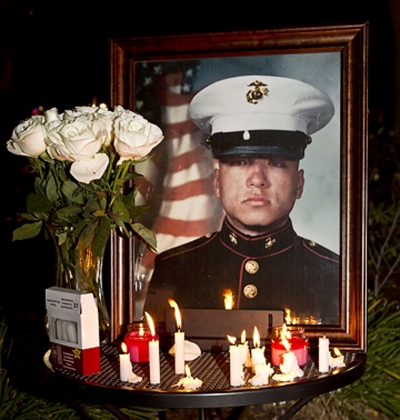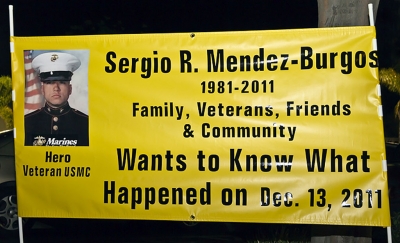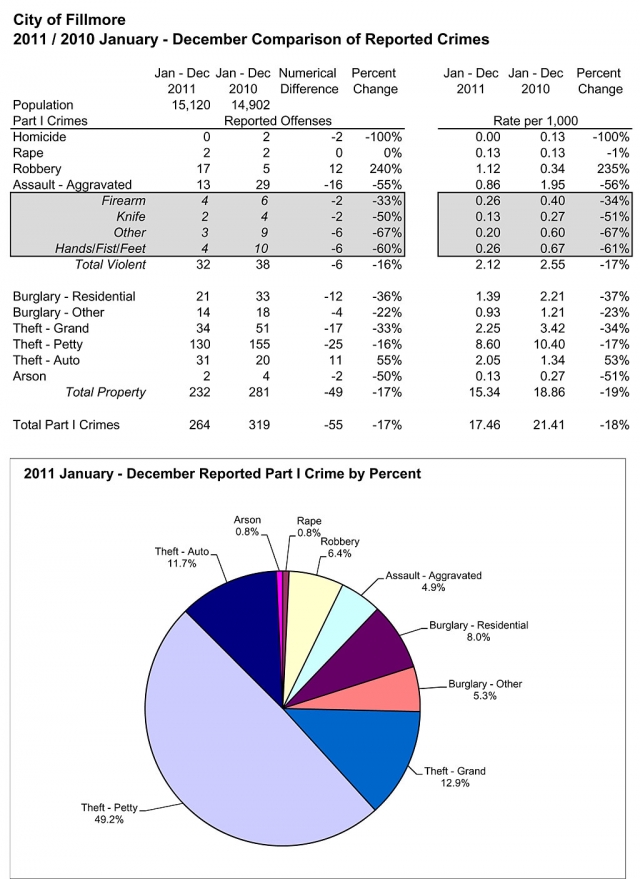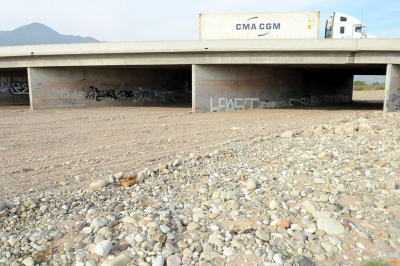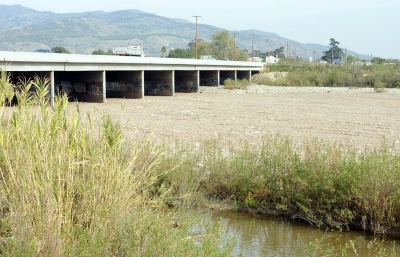|
By Ventura County Sheriff Department — Wednesday, February 15th, 2012
Shortly after 8 p.m. Friday night, deputies from the Fillmore Police Department responded to Rite-Aid on a call of a combative shoplifter fighting with store employees. Arriving in less than two minutes, deputies found (S) Peter Martinez 38, Fillmore, being held on the ground by two store employees and a customer. The investigation determined Martinez had secreted seven “Secret” brand deodorant products (valued at less than $40 total) in a plastic bag he’d brought with him into the store. Martinez purchased some other items, but failed to pay for the deodorant and walked out of the store with the stolen merchandise. A loss prevention employee who had watched Martinez commit the theft, identified himself as a loss prevention officer with the store and attempted to stop him outside the store. Martinez fought with the loss prevention officer in an effort to escape, turning the misdemeanor shoplift into a felony robbery. A second store employee and a customer assisted the loss prevention officer in detaining Martinez until deputies arrived. The store employees suffered minor injuries in the struggle; the customer was uninjured. Martinez was booked into the Pre-Trial Detention Facility for 211 P.C. Robbery, with bail set at $120,000. Courtesy of Fillmore Police Department. |
 Mayor Gayle Washburn presented Deputy Brian Hackworth (center) a proclamation for his services in Fillmore. Hackworth was also 2011 Officer of Year, (right) Fillmore Police Chief Monica McGrath. Enlarge Photo By Jean McLeod — Wednesday, February 15th, 2012
 Fillmore citizen Allan Hair was presented with a proclamation for his service on the Fillmore Senior Center Board, at Tuesday night’s City Council meeting. Enlarge Photo  El Pescador Restaurant owner Jesus ‘Chuy’ Ortiz accepted a proclamation from the Fillmore City Council on Tuesday night recognizing the Martin Luther King Jr. Day of Service: Fillmore Two Rivers Park Clean-Up sponsors and volunteers. Enlarge Photo  Fillmore Fire Chief Rigo Landeros accepts a proclamation from Mayor Gayle Washburn on behalf of the City’s Public Works Department at Tuesday night’s City Council meeting. Enlarge Photo There were a number of proclamations given out at Tuesday’s Fillmore City Council Meeting along with a long awaited Council approval to pay for the gate to the Fillmore High School running track. Also, there was a presentation on the new meters being installed by Southern California Edison (SCE) and a status report on the Tobacco Awareness Program. After years of going back and forth between the City Council and the School Board funding for the gate was given a vote of approval by the Council. Councilmember A. Eduardo Gonzalez brought it to a vote acknowledging there was no guarantee that the City would be reimbursed by the various clubs that promised to do future fundraising to pay for it. The vote was 4-1 with Mayor Gayle Washburn the only No vote. Anna M. Frutos-Sanchez from SCE gave a presentation on an item that will have an impact on anyone who pays a residential electric bill. Edison’s Smart-Meter is replacing the mechanical meters that have been around for decades. The new digital meters use wireless technology to transmit encrypted information on electricity use and are being installed as part of the “smart” grid initiative, spearheaded by technology firms and backed by the Obama administration and the Department of Energy. In addition to the Smart-Meter there is the Edison SmartConnect program designed to give customers more information, and in the future allows customers with communicating, energy-smart thermostats and appliances to automatically respond during critical peak pricing and grid reliability events. But this comes with a price; customers will see a 1.6% increase in rates during the program’s four-year installation period. Edison has installed 3.9 million meters in other areas around the State since September 2009 and will start in Ventura County in March. When the meter is replaced there is a brief five minute power outage and any household with medical equipment or life support equipment needs to contact Edison beforehand. Not everyone is happy about this latest form of progress. Several people voiced concerned about reports citing people with sensitivity to electromagnetic and radio frequency having experienced headaches, nausea, trouble sleeping and other medical problems that the smart meters may cause. Others have concerns about privacy issues. The technology is so sophisticated the meters can individually identify electrical devices inside homes and record when they are being operated, then record and store databases of private and personal activities and behaviors without the consent or knowledge of those people who are monitored. This reveals activities such as when residents are home, sleeping, on vacation, etc. Residents in some areas served by Pacific Gas and Electric are opposing the installation and other counties have banned their installation altogether. In some cases PG&E has reversed course, replacing the ‘smart’ meters of those customers reporting health impacts with the old analog version. On February 1, 2012 the California Public Utilities Commission (CPUC) modified PG&E’s Smart meter program to include an analog meter option for residential customers who do not wish to have a smart meter installed at their location. There is an initial fee of $75 to opt-out and a monthly charge of $10. CARE customers (a reduced rate program for low income households) have an initial fee of $10 along with a monthly charge of $5 to opt-out. Edison is actively participating in the CPUC’s ongoing opt-out process for residential customers and those who do not have a smart meter installed can delay installation by contacting SCE at (800) 810-2369. There were four proclamations given out, starting with Ventura County Sheriff’s Deputy Hackworth who is transferring from Fillmore’s Sheriffs to the Sheriff’s Civil Division. Hackworth, a Fillmore resident, was the 2011 Officer of the Year and trained 80% of Fillmore’s Sheriffs’ workforce. Next to be recognized was resigning Senior Center Board Member and volunteer Allan Hair for five years of service that helped revive the center. Donna Boelker, President of the Board, also presented Hair with a proclamation. Boelker stated, “Allan has been a blessing in so many ways…someone you can rely on.” Hair spoke from the heart and invited all the seniors to visit the center and added, “Through Scott Lee I learned what it’s like to be involved.” The volunteers for Martin Luther King Day of Service received the next proclamation. Many of Fillmore’s best young people come out and lent a helping hand doing clean-up. Some of those young people were Daniel Gonzalez, Luis Cruz, Marysol Rojo, Adriana Zamora and Iris Villalobos from One Step a La Vez. There was also a great group of volunteers from the Boys and Girls Club and sponsors like Cabrillo Economic Development, El Pescador, Starbucks, Francisco’s Fruit, Fillmore Water Store and others. The Council also wanted to thank the Public Works Department with a proclamation for all they do; like coming out at 4:00am to fix a water leak. Fire Captain Rigo Landeros accepted on the Public Works’ behalf. Christina Villasenor from the Fillmore Family Coalition and Alejandro Elias with the Ventura County Department of Public Health gave a status report on the Tobacco Awareness Program for retailers. According to their research 20% of Fillmore retailers selling tobacco items are selling to children under 18, which is a violation of Penal Code 308. There was originally a proposal to create an ordinance to help curb sales to minors but it was rejected and instead an education program by the Public Health staff was agreed upon. Villasenor told the Council, “We don’t want to punish (retailers), we just want compliance.” Robert Smith was appointed to a four year term on the Planning Commission on October 2011 for a term that would expire three months later on January 26, 2012. Applications for the position were advertised in the January 26, 2012 edition of the Fillmore Gazette; only one application was received and it was from Robert Smith for re-appointment. Community Development Director Kevin McSweeney presented the Council with answers to questions on a zoning ordinance amendment allowing larger signs on businesses and permit streamlining that were brought forth during the January 25th Town Hall Meeting. McSweeney told the Council his department is working on streamlining the permits process and changes have been made. For example, simple projects like patio covers that used to take 1-2 weeks for approval can now be issued in one day. Changes to the one-third retail requirement on Central are also being discussed and considered. McSweeney said a change in signage would require a great deal more and could cost as much as $30,000. Of concern was the first block just north of Highway 126 on Central. It was described by a Council Member as blighted and they repeated comments made by visitors stating they thought it was a street of abandoned buildings. There was concern by the Council for the businesses and the impact on having to replace a sign that could still be usable; but there are also rules of abandonment when a business has not used a sign for over six months which falls under code enforcement. But, code enforcement is one of the departments that may be cut back severely due to the City’s financial problems. The Koffee Kiosk on Highway 126 is an example of an abandoned business sign. Councilmember Steve Conaway stated, “I’m concerned with the cost of this…I’d like to hear from the businesses.” |
|
By Anonymous — Wednesday, February 15th, 2012
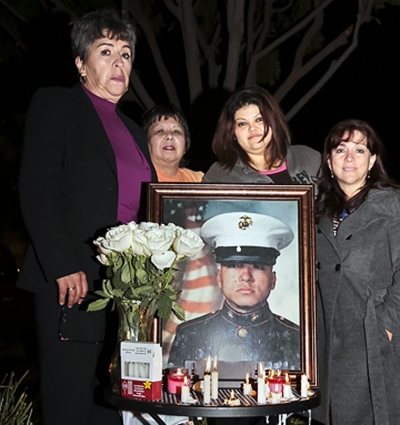 Family and friends attended a memorial vigil across from Starbucks Friday, to commemorate the death of Sergio Mendez who was killed in a bizarre accident. Pictured (l-r) Belen Burgos, Nathalie Bagasso Miliken, Cinthya Mendez, and Clara Quimbayo. Enlarge Photo A memorial vigil attended by family and friends of Sergio Mendez took place Friday evening across from Starbucks. Mendez, a former Marine, was sitting in the Fillmore Starbucks on December 13, 2011 when a vehicle traveling at high speed smashed through the building pinning him against an interior wall. Mendez died shortly thereafter during surgery at Ventura County Medical Center. Mendez aunts, Clara Quimbayo and Belen Burgos, told interviewers that they were seeking an “impartial investigation of what happened.” They are concerned that the investigation may be biased due to the fact that the Two months have passed since the incident and very few facts have been released, except for reports that “neither drugs nor alcohol appeared to be a factor in the crash.” The possibility of loss of consciousness is being investigated. The vehicle, westbound on Highway 126, crossed two lanes of traffic, jumped a curb, tore through a short hedge and traveled 130 yards through a parking lot before crashing through the east wall of Starbucks. Reports stated that family members were waiting for word from Ventura County District Attorney Greg Totten’s office as to whether or not criminal charges would be filed. |
|
By Anonymous — Wednesday, February 15th, 2012
|
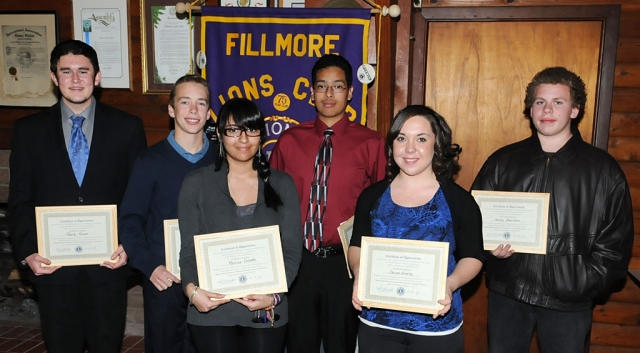 Monday night the Fillmore Lions Club held their Annual Speaker Contest. Pictured (l-r) Speaker winner Roberto Munoz with Nick Johnson, Marissa Dorantes, Jovanny Bravo, Darian Binkley, Wesley Brecheen. Enlarge Photo By Anonymous — Wednesday, February 8th, 2012
 Roberto Munoz, a senior at Fillmore High School, took first place for a third year in a row at the Fillmore Lions Club Speaker Contest. On Monday, February 6 the 75™ Annual Lions student speaker contest was held at the scout house with over 50 Lions, speakers, friends and family present. The topic on which they spoke about was “What could the America of yesterday teach the America of tomorrow?" |
|
By Anonymous — Wednesday, February 8th, 2012
Governor Edmund G. Brown Jr. today announced the following appointments. M. Cecelia Cuevas, 48, of Fillmore, has been appointed to the 31st District Agricultural Association, Ventura County Fair Board. Cuevas has been a senior financial advisor for Merrill Lynch since 2004. She was director of development and communications for the American Red Cross of Ventura County from 2002 to 2004 and development director for the Coalition to End Domestic and Sexual Violence from 1997 to 2002. She has served as mayor pro-tem for the City of Fillmore from 2006 to 2008 and city councilmember from 2000 to 2006. Cuevas is the immediate past president of the California Coalition Against Sexual Assault. This position does not require Senate confirmation and there is no compensation. Cuevas is a Democrat. |
 A westward view of the Fillmore bridge crossing Sespe Creek shows the recent cleanout of rock and debris at the center. Upland Rock has completed the work of grading and removing debris which accumulated over the years at the center of the bridge. The rock presents a flood threat for the western part of the city. Enlarge Photo By Jean McLeod — Wednesday, February 1st, 2012
Sespe Creek is getting a great deal of attention these days. In addition to the Ventura Watershed Protection District putting in a new levee, Upland Rock at Sespe Creek is also working on removing the large amount of collected debris blocking the channel under the east Sespe Creek bridge located on Highway 126. Sespe Creek, which originates above 5,000 feet elevation in the Los Padre National Forest, drains a major portion of the Sierra Madre Mountains and 342 acre of Sespe Wilderness into the Santa Clara River. The name Sespe can be traced to the Chumash Indian village, called Cepsey or Sek-pe in a 1791 California land grant. It was important to the native tribe, which foraged and hunted along the creek. Sespe Creek is the largest of the 30 tributary creeks running into the Santa Clara River, which is the longest relatively natural river remaining in Southern California. The Sespe is 51 miles long and joins the Santa Clara River in Fillmore through an east and west channel that both cross Highway 126. But, according to James Sandoval, owner of Sespe Materials (the company that mined the creek for many years), a significant flood years back diverted the water’s flow to the east channel. Sandoval, at the time, wanted to restore the flow to the west channel, but a Fillmore homeowner refused him needed access to do the work. Sandoval said, “It has been at least 20 years since the west channel has flowed.” The County of Ventura has designed and mapped out all rivers and creeks that flow within its boundaries which includes Sespe Creek. But in the past decade, several fires have burned hundreds of acres of the dense chaparral around Sespe’s watershed and the creek has been laden with considerable sedimentation which fills in many of the deep pools that the lower Sespe is known for. The debris and sediment deposits under the Highway 126 west Sespe Creek overpass (which is long and wide enough to accommodate two lanes in each direction plus and ample median and shoulders) are preventing a proper flow and shifting the streambed in both left and right directions of the designated map. This is also causing flooding of the ranches along its banks. Some areas of debris, which includes sand, rock and vegetation, have reached over nine feet high with the creek itself 14 feet above grade. One of the main culprits causing problems is the non-native plant Arundo, which has taken over large areas of both Sespe Creek and the Santa Clara River. A tall perennial, cane-like grass that resembles bamboo, Arundo is an invasive species that during flooding rhizomes break off and travel downstream where it continues to invade due to its aggressive growth and ability to survive. Once Arundo is established the area requires continual costly cleanup and maintenance because it creates a fire hazard, flood hazard, sedimentation, and erosion. The plant collects at bridges, drainage pipes and other flood control structures, causing compromised functioning and in some instances structure failure along with degrading the natural resources. As the plant spreads the areas stop functioning as native systems. The entire ecological cycle of the riparian system is impacted which includes the habitat that plants, birds, fish, animals and insects rely on. A number of agencies (Cal Trans, Ventura County Watershed Protection Dept., California Fish and Game, just to name a few) have a responsibility for keeping the Sespe water flowing properly, but because of the expense involved it is not a high priority. To Fillmore it is a safety issue, which is a high priority. Flooding creek waters can move boulders as large as 20,000 lb creating dammed up areas and flooding, but it is also a danger to bridges or any other structure in the way. The trusses supporting the Sespe Creek overpass have already sustained damage in the past due to buildup and were repaired by Sandoval. Because of the financial state of both the State of California and Ventura County, the funding for cleaning out the creek is put at the bottom of the list. Many municipalities have started looking to partner with private companies to help offset the costs. This is where Mike Grabowski and Rocky Dreher, owners of Upland Rock steps in; opening up the Sespe Creek channel helps the environmental habitat by extracting the marketable material (boulders, gravel and sand) for sale to local businesses, and helps lower the costs to those responsible municipalities. But, growing environmental concerns and opposition to mining have had an impact on the mining industry and a loss of local mining business in Ventura County. Rock and sand materials have for years been transported from mining companies extracting materials from the deserts of Palmdale and Lancaster; but transportation adds to the cost of those materials. Today’s approach to mining is more environmentally friendly but there is still a need to supply the growing demand for materials at a cost the consumer and taxpayer can afford. Having Upland Rock as a local supplier brings down transportation costs of the materials used to build our local roads, bridges, building, homes and numerous other applications. Taking on such a project is not a simple task due to the numerous municipalities involved and all the regulations. Biological monitoring is required prior to disturbing the site as well as a biologist on site, at a cost of $1,000 per day, while work is being preformed. The confluence of Sespe Creek with the Santa Clara River provides an important connection to upland systems and migration of the wildlife that depend on a free flowing waterway. Any disturbance of the creek brings environmental issues of protecting a number of endangered species such as the Arroyo toad, California Red-legged Frog, California Condor, Southern Steelhead Trout, songbirds Southwestern Willow Flycatcher and Least Bell’s Vireo. Currently, most of the creek is closed to fishing due to efforts to reestablish a Steelhead run. Before Upland Rock could proceed with the cleaning out the creek an extensive list of engineering and environmental studies had to be prepared and approved. These included: Conditional Use Permit approved by the Ventura County Resource Management Agency; Reclamation Plan and Financial Assurance Bond approved by the California Department of Conservation, Office of Mine Reclamation; Section 404 Permit approved by the U.S. Army Corps of Engineers; Special conditions from the National Oceanic and Atmospheric Administration’s National Marine Fisheries Service were incorporated into the project to reduce the impacts to steelhead trout that migrates up the Santa Clara River to spawn in Sespe Creek and other critical habitat; Lake or Streambed Alteration Agreement approved by the California Department of Fish and Game, which includes a Mitigation, Re-vegetation and Biological Protection Plan; Water Quality Certification approved by the California Regional Water Quality Control; Encroachment Permit approved by the Ventura County Watershed Protection District; Encroachment Permit approved by the California Department of Transportation; Permit to Operate approved by the Ventura County Air Pollution Control Board. Each of these municipalities with their own concerns and regulations rarely communicate with each. To get all the agencies “talking” to one another Upland Rock hired Sespe Consulting added an additional 40% to the projects operational costs. Regulations require the work can only be done when the water is 75 degrees or above (the water in Sespe Creek can warm by 20 degrees over the course of the day) and the creek’s flow is low, leaving few days or hours to work on the project, usually the only months when work can be done is November through December. Snow pack and year-round running springs supply the stream with a constant flow. Historically the highest crests have been January through March with February 10, 1978 recording the highest at 22.40 feet and the lowest level on record was 3.44 feet on September 1, 2004. Upland Rock started the project the week before Thanksgiving and was given 15 days to complete it with a one week extension for just cleaning up and no mining. In addition to all of the agency approvals, environmental mandates require that the water may not be disturbed by the project. To accommodate this, railroad cars, which are strong enough to care a heavy load, were stripped of their siding and the undercarriage used to create bridges over the streambed to carry the 35 ton equipment needed to extract the rock and sand. Also no chlorinated water may be added to the creek, only the creeks water may be used to wash the materials and equipment, so pumping equipment for that purpose needed to be brought in and used. The vegetation along the creek consists of typical riparian species such as Willow and Cottonwood which Upland Rock carefully harvests and propagates into containers for replanting when the work is completed. During the Nov-Dec 2011 phase over 100,000 cubic yards of material was extracted, but with the creek still being 14 feet above grade, a great deal of material needs to be extracted in the future. Upland Rock will be returning in December of this year to start phase 2. This is not the first time the debris has been cleaned out. Sandoval, who also owns Blue Star Materials in Moorpark, had done the cleanup from 1992 through 2010. Last year Upland Rock took over the remaining six years of a 25 year Conditional Use Permit originally issued to Sandoval and will continue the cleanup for the permit’s remaining five years, as long as the price of rock and sand make it financially feasible. The cost for Upland Rock to take over the project was $150,000. If Upland Rock had not taken over the project from Sandoval and had to start from the beginning the costs would have been between $200,000- $500,000 and probably not something the company would have considered taking on. |
|
By Anonymous — Wednesday, February 1st, 2012
On Saturday, January 14, 2012 Brian Ball, a 2003 graduate of Fillmore High School, competed in his first Olympic Marathon Trials in Houston, TX. On race day 123 athletes were registered to run and out of that group 114 showed up at the start. Only 85 runners completed the race. Brian finished in 39th place with a time of 2:17.38. He is the training partner of 2004 silver medalist and 2009 New York City Marathon Champion, Meb Keflezighi who won the Trials and will compete in his third Olympics. Brian has been training for the last three years in Mammoth Lakes, CA. Brian started his running journey in high school as a sprinter/middle distance runner competing primarily in the 200 and 400-meter events. He ran cross- country his senior year to get in shape for track season. He was the number three or four man on a team that won league and got second at the state meet. During college at BIOLA University, he ran cross- country and track. He was injured his first track season but began his second year running the 800/1500. His final two seasons he competed in the 5k and 3000-meter steeplechase. He was a six time NAIA All American (3 years cross country/ 3 years track) while at BIOLA. After a successful college career, he still had the desire to compete and felt he hadn’t reached his potential. With the encouragement of his parents, he headed off for Mammoth Lakes to train in altitude. Not knowing anyone, he trained alone for a month before he saw some of the Mammoth Track Club runners and was invited to a work out. Josh Cox, Olympians Ryan Hall, Meb Keflezighi and Dan Browne a former Westpoint graduate and current Major in the US Army accepted Brian into their group. He has trained primarily with Meb and Dan the past three years with the help of former Hall of Fame Coach at UCLA, Bob Larsen. Bob has coached Meb since his college days at UCLA. Brian feels very blessed to have Meb and Dan as friends that share his Christian faith and a common interest in running. They have become his mentors. |




